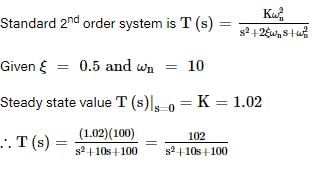Test: Time Response Of First Order Systems - Electrical Engineering (EE) MCQ
10 Questions MCQ Test - Test: Time Response Of First Order Systems
A unit step is applied at t=0 to a first order system without time delay. The response has the value of 1.264 units at t=10 mins, and 2 units at steady state. The transfer function of the system is_____________
The transfer function of the system is G(s) =100/(s+1) (s+100). For a unit step input to the system the approximate settling time for 2% criterion is:
If a first order system and its time response to a unit step are as shown below, the gain K is :
The unit impulse response of a system having transfer function K/(s+a) is shown below. The value of a is :
A system with transfer function 1/Ts+1, subjected to a step input takes to seconds to reach 50% of step height. The value of t is :
A second-order real system has the following properties:
The damping ratio ξ=0.5ξ=0.5 and undamped natural frequency ωn=10rad/sωn=10rad/s, the steady state value at zero is 1.02.
The transfer function of the system is
Assertion (A): It is observed that step function is first derivative of a ramp function and impulse function is first derivative of a step function.
Reason (R): From the derived time response expression it is concluded that the output time response also follows the same sequence as that of input functions.
Laplace transform of unit impulse signal is :
Time response during steady state the output velocity matches with the input velocity but lags behind the input by T.















